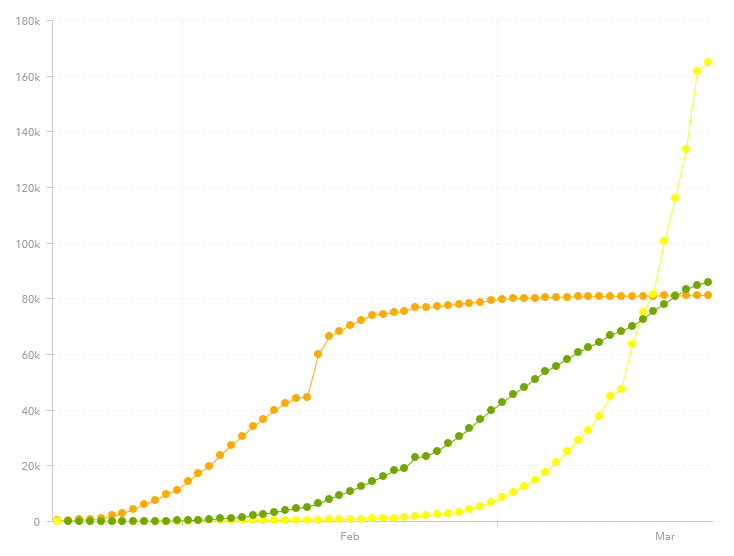
Well, situation keeps getting worse, and in a lot of different places in the world. The number of cases outside of China is growing rapidly and does not appear to be slowing down. China continues to report very few new cases. On 11 March they had 80.9K cases. Ten day later they are at 81.3K cases. So it is only growing by less than 40 cases a day. Still. Wednesday morning it was 81,102, and it is now 81,250. This is 148 cases in two days. This is not quite contained. If one relaxes some of the restrictions for the sake of getting the economy working again, what happens?
Country……….Cases……Deaths……Rate
World Wide……246,276….10,038….…4.08%
China.……………81,250……3,247……..4.00%
Italy………………41,035……3,405……..8.30%
Iran………….……18,407……1,284……..6.98%
Spain……………..18,077………833…..…4.61%
Germany………..16,290….….…44….….0.27%
United States……14,250….…..205….….1.44%
France……………10,891………371….….3.41%
S. Korea…….…….8,652….……94….….1.09%
Switzerland…….…4,164….…….43….….1.03%
United Kingdom.…3,297……….144…..…4.37%
Netherlands.………2,468.……….76……….3.08%
Austria………….…2,203..……..…6…..….0.27%
Norway……………1,802..…..……7………0.39%
Belgium….….….…1,795……..…21……….1.17%
Sweden…..….……1,439……..…11…..…..0.76%
Denmark..….……..1,225……….…6……….0.49%
Sixteen countries around the world with over a thousand cases. Below is a list of some of the rest. They are mostly European but countries from all over the world are joining the list. Not sure how much more extensive testing influences these figures.
Country……..…Cases……Deaths……Rate
Japan………………943..……….33.……..3.50%
Malaysia….…..……900……….…2………0.22%
Canada……..………872…………12….…..1.38%
Portugal.…..….……785……….…4……….0.51%
Czech Rep…………694……….…0…..…..0%
Australia……………681..…..….…6….…..0.88%
Israel…….…….……677…………..0….…..0%
Brazil………………..621………..…6………0.97%
Ireland……………….557……….…3.………0.54%
Greece..….……..….464………..…6………1.29%
Qatar..………..…….460..……….…0…..…..0%
Pakistan……….……454………..…2…..…..0%
Finland….…………..400……….…0….……0%
Turkey……………….359…..….….4….……1.11%
Poland………….……355…………5……….1.41%
Singapore…..……….345…………0….……0%
Chile..……………..…342………….2………..0.58%
Luxembourg.….…….335…..…..…4…….…1.19%
Iceland…………..…..330……….…1….……0.30%
Slovenia….……..…..319………..…1….……0.31%
Indonesia….….…….311…………25……….8.04%
Bahrain………………278…….……1………..0.36%
Romania……………277………..…0…….….0%
Saudi Arabia…….…274…………..0…..……0%
Thailand.…..……….272………..…1…………0.37%
Estonia…..…………267……..……0…………0%
Ecuador.….…..……260……………3……..….1.15%
Egypt………………..256……..….…7….,,,.….2.73%
Hong Kong….…..…256……..….…4…..……1.56%
Peru…………………234…….…..…1……..….0.43%
Philippines………….217…………..17…………7.83%
Russia…….……..…199……………1…….….0.50%
India……………….…194….……..…4.…..…..2.06%
Iraq…..……………..192..…..….…13………..6.77%
Lebanon……..….…157..……..……3….……1.91%
South Africa……..…150……..…..…4……….2.67%
Kuwait……….……..148..…..………0…..…..0%
San Marino…………144…….…….14….……9.72%
UAE……………..….140……..…..…0……….0%
Panama……..…..…137…..….…….1…..…..0.73%
Taiwan…………..…135…..….…….2…..…..1.48%
A few other entities of interest to this author that have less than 135 cases so far:
Mexico…….….……118………..…1….……0.85%
Algeria…….….……..90……………9………10.00%
Vietnam….……….…85….…..……0……….0%
Azerbaijan..……..…..44…….…..…1……….2.27%
New Zealand………..39……………0…….…0%
Ukraine……………….26.………..…3….….11.54%
Palestine…..…..……26?………….0……….0%
Afghanistan…….……22….……..…0……….0%
North Korea..…………0…….…..…0…….…0%
Syria……….…………..0…….……..0…….…0%
Yemen……….….……..0…………..0……..…0%
Libya……….……….…..0…………..0……..…0%
Diamond Princess….712…………7……..….0.98%
Part of my concern is the spread of the disease across the Middle East and Central Asia. There are a number of countries in the region still at war, including Syria, Afghanistan and Iraq. How does one contain a virus in a country at war? Do they then serve as a vector for the rest of the countries in the region?
Data is from Johns Hopkins CSSE 3/18/20 as of 9:43.03 AM EST. It was only updated twice while I was writing this. It is here: Johns Hopkins CSSE
A few more observations:
- It does appear that at best the mortality rate is around 1% if: 1) there is good health care and 2) there is good reporting. That appears to be borne out by the reporting from South Korea and the more contained environment of the cruise ships.
- The S. Korean mortality rate is now above 1%. They have tested more than 240,000 of their people. This is about a good and complete reporting as we are going to see in the real world. It is getting harder to make the argument that the mortality rate is much less than 1%, even assuming a large number of cases were not reported.
- Most other countries with a reported rate of less than 1% I suspect have just recently gotten a number of new cases and these figures will be unfortunately changing over time (for example Germany).
- See the comment to update 9. The poster I gather is making the argument that the actual mortality rate is well less than 1%, based upon the example of Germany. This bears watching.
- Of course, what is the actual mortality rate is a big issue if one is going to do any estimate of potential impact (population * percent infected * mortality rate and modified by improvements in care and developments of vaccines). I have been thinking about post about this at some point…but…
- If mortality really is around 1% or less, then it appears there are already over 340,000 in cases Italy and over 120,000 cases in Iran.
- Now it could be that the natural mortality rate in Italy will be higher than what we are seeing for S. Korea. This will be explored in a future post.
- San Marino has a population of 33,562. With 144 cases, this makes it the “most infected” country in the world with 0.43% infected.
- The Holy See (Vatican City) is second with 1 case in around 1,000 people (0.10%)
- Italy with 60,317,546 people and 41,035 cases is third (0.068%)
- If they really have over 340,000 cases then we are looking at almost 0.6%, a figure similar to San Marino (which makes sense).
- I still suspect 44 U.S. passengers from the Diamond Princess are being double counted in CSSE database. They are now listed as a subset of the Diamond Princess button, but I suspect they are still being counted in the U.S. totals.
- Also, Hong Kong’s 256 cases are also counted under China. I just choose to separate out Hong Kong because there is a political protest movement of some significance going on there.
- Palestine was reported last week to have 26 cases. Now the CSSE database does not report on Palestine. Not sure where those 26 cases went to. Are they reported under Israel?
On the graph at the top of this post, the new top line is the number of coronavirus cases in “other locations” (meaning outside of mainland China). The original top line is the number of coronavirus cases in Mainland China (People’s Republic of China). The next line is the “Total Recovered” which is reported at 86,036 out of 246,276 cases (and 10,038 deaths). It has now just passed the Mainland China line.
